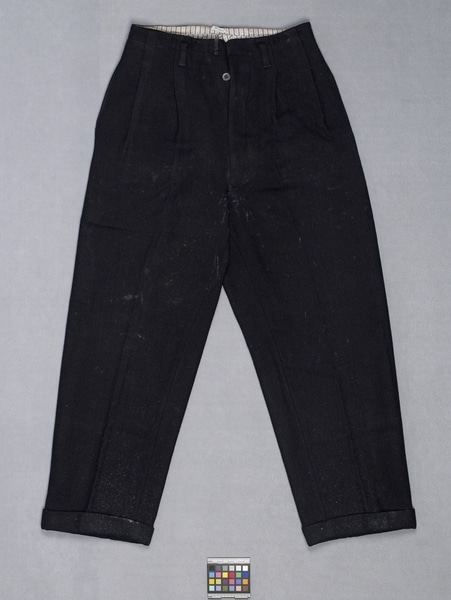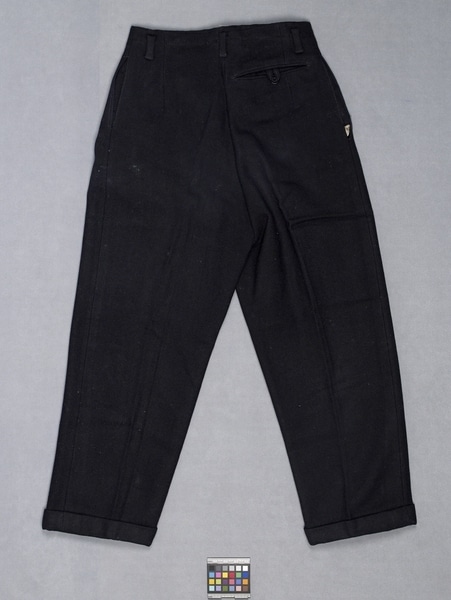Pants Item Number: Edz1068 b from the MOA: University of British Columbia


Description
Black wool pants (part b). The pants have a narrow waistband and a centre opening with a hook and eye closure and button fly. There are belt loops, pleats, two inner side pockets and a back inner right pocket. The pant legs are straight with a bottom cuff. The inside of the waistband is lined with cream and blue striped cotton. The inner seams are serged with white thread.
History Of Use
After the mid-twentieth century the New Territories of Hong Kong began to undergo fundamental changes. The people who had been settled there before 1898, when the British colonizers claimed the area, began to give up rice agriculture and coastal fishing, turning instead to wage labour and increased employment overseas. By the end of the century, educational opportunities leading to the possibility of white-collar work also increased, together with western influences. Men’s clothing reflected western influences earlier than did women’s clothing, which changed relatively little until the 1970s and even after. Suits like this one reflect western influences in everything except the collar. In the rural villages, wool fabric was also not used until at least the mid-twentieth century, and remained uncommon even afterwards. Before that time, people who could afford winter clothing used fabric padded with cotton or silk, not wool. Because of poverty, many people in Tsuen Wan District made do even in winter with one or two layers of unpadded clothing. Twentieth-century changes meant that objects and clothing once useful and appropriate were no longer needed and generally were discarded. Some were saved by their owners, who sometimes were willing to donate them to museums, sharing, also, their knowledge of how they were made and used.
Narrative
Mr. Chan, Kun-lam wore this suit in the winter on special occasions. By the time he donated it, the suit was well-used and probably out of fashion. It had probably been custom-made for him by a tailor. Hakka people are one of the two original land-dwelling groups that settled the area that became the New Territories of Hong Kong. Their spoken language, and some customs, differed from those of the other original group, the Cantonese or Punti. The Cantonese arrived first and settled on the best rice-growing lands, while the Hakka began to arrive after the late 17th century and settled the more hilly lands.
Item History
- Made in Tsuen Wan, Hong Kong, China
- Collected by Elizabeth L. Johnson during 1979
- Owned by Kun-lam Chan
- Owned by Elizabeth L. Johnson before March 17, 1980
- Received from Elizabeth L. Johnson (Seller) and Museum of Anthropology Shop Volunteers (Funding source) on March 17, 1980
What
- Name
- Pants
- Identification Number
- Edz1068 b
- Type of Item
- pant
- Material
- wool fibre, dye and cotton fibre
- Part B
- height 97.5 cm, width 68.0 cm
Who
- Culture
- Chinese: Hakka
- Field Collector
- Elizabeth L. Johnson
- Previous Owner
- Kun-lam Chan and Elizabeth L. Johnson
- Received from
- Elizabeth L. Johnson (Seller) and Museum of Anthropology Shop Volunteers (Funding source)
Where
- Holding Institution
- MOA: University of British Columbia
- Made in
- Tsuen Wan, Hong Kong, China
When
- Collection Date
- during 1979
- Ownership Date
- before March 17, 1980
- Acquisition Date
- on March 17, 1980
Other
- Item Classes
- textiles
- Condition
- good
- Accession Number
- 0610/0038